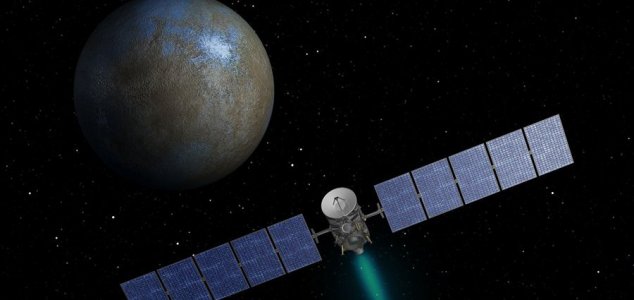Space & Astronomy
January 23, 2014 · 10 comments
10 comments

Artist's concept image of Dawn approaching Ceres. Image Credit: NASA/JPL-Caltech
The well-timed discovery coincides with the upcoming exploration of Ceres by NASA's Dawn spacecraft which is due to arrive in orbit around it next year. The enigmatic world has proven a tantalizing target for scientists who are hoping that Dawn's visit will discover more about how it came to be there and where the water plumes could be coming from.
One theory suggests that there could be a layer of ice just beneath the surface that is heated by the sun, causing the water to erupt in the form of ice volcanoes.
"It makes Ceres a more exciting target," said ESA's Michael Kuppers.
Source: ABC News | Comments (10)
Plumes of water discovered on Ceres
By T.K. RandallJanuary 23, 2014 ·
 10 comments
10 comments
Artist's concept image of Dawn approaching Ceres. Image Credit: NASA/JPL-Caltech
Scientists have discovered signs of water on Ceres, an icy dwarf planet located in the asteroid belt.
Measuring 950km in diameter and located in the asteroid belt between Mars and Jupiter, Ceres is the smallest and closest dwarf planet ever discovered. Now scientists observing the icy world through the Herschel Space Observatory have identified what look like plumes of water spewing from its surface.The well-timed discovery coincides with the upcoming exploration of Ceres by NASA's Dawn spacecraft which is due to arrive in orbit around it next year. The enigmatic world has proven a tantalizing target for scientists who are hoping that Dawn's visit will discover more about how it came to be there and where the water plumes could be coming from.
"It makes Ceres a more exciting target," said ESA's Michael Kuppers.
Source: ABC News | Comments (10)

The Unexplained Mysteries
Book of Weird News
AVAILABLE NOW
Take a walk on the weird side with this compilation of some of the weirdest stories ever to grace the pages of a newspaper.
Click here to learn more

Support us on Patreon
BONUS CONTENTFor less than the cost of a cup of coffee, you can gain access to a wide range of exclusive perks including our popular 'Lost Ghost Stories' series.
Click here to learn more
Israel, Palestine and the Middle-East
UK and Europe
Natural World
United States and the Americas
Total Posts: 7,606,605 Topics: 316,388 Members: 201,841
Not a member yet ? Click here to join - registration is free and only takes a moment!
Not a member yet ? Click here to join - registration is free and only takes a moment!

























Please Login or Register to post a comment.